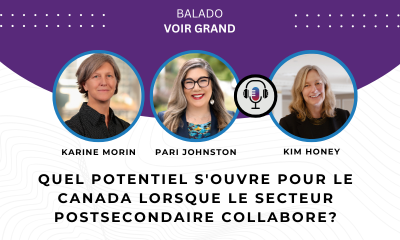What does social justice mean to you, and how can research help advance it to forge the future you want? To mark its 25th anniversary, the Canada Foundation for Innovation hosted a panel discussion around this topic at Congress 2022. Joining moderator Dr. Lesley Gittings (University of Toronto) were Dr. Lindsay Galway (Lakehead University), Dr. Manu Sharma (Thompson Rivers University), and Dr. Rinaldo Walcott (University of Toronto) to answer the youth-focused question.
The concept of social justice has come to mean different things to different people, Dr. Walcott explained. It’s a contested term that we must continuously work on, think about, and redefine, especially in such a deeply inequitable world. “For me, working under the rubric of social justice, I’m often thinking about Black youth cultures, queer cultures, the manner in which multiculturalism shapes the experiences of non-white people, questions of education, questions of policing, questions of criminality, questions of creativity…” Walcott said.
Dr. Galway — whose research aims to examine and address the social and health dimensions of climatic and environmental change with a focus on promoting health, sustainability, and justice — describes her work as being place-based, place-responsive, and community-engaged. By exploring the intersections between climate change, land, and health, Galway’s work seeks to foster intergenerational relationship building and knowledge sharing. One recent project, for example, established a climate action field school along the Lake Superior watershed through partnerships with scholars, community workers, and First Nations communities. Such collaborative, local initiatives illustrate the ways that students and community organizations can work together in service of social justice locally — indicative of Galway’s overall approach to social justice work: grounded in locally relevant issues, and expanding from there.
The idea of “place” with regard to social justice education sparked discussion among the panelists. Given that justice initiatives are articulated differently in different parts of the world, should curriculums be entrenched in local issues, or global ones?
Dr. Sharma has spent more than a dozen years working in K-12 and postsecondary institutions in Canada and abroad, teaching through the lens of social justice and with the goal to make compulsory public schooling equitable for all. “The short answer is yes: social justice issues in schools should look both locally and globally,” Sharma explained. “The general idea is that students should be aware not only of what happens close to home, but in other places and other contexts.” Part of the responsibility of educators is to open the minds of students and create opportunities to look at what is happening in other places where oppression occurs — but educators within their local contexts must determine how to achieve this.
In Dr. Walcott’s courses, for example, he starts by considering local contexts and then builds outward, expanding to think through how local conditions are exemplary of what might be happening elsewhere in the world. In doing so, Walcott encourages the doctrine of thinking locally and acting globally.
This pedagogical approach is influenced by who is in his classroom. Walcott acknowledged that it is crucial to build a curriculum that reflects the range of identities that may be present, and to make the classroom a space where all students feel free to express themselves. “Students are not empty vessels to be filled with knowledge from me,” Walcott noted. He proposes that we ask, in particular in interactions with racialized, Indigenous, and queer youth:
“What does it mean for me as an adult to be able to step aside so that younger people can begin to articulate the world that they need, and when can I step back in to support that?”
Indeed, many students are already involved in their own areas of activism. Walcott noted that at his institution, students actively push for the administration to divest from the fossil fuel industry. By making space for young people to imagine and articulate their vision of the world, educators can help empower them to achieve it.
Addressing local contexts can pose challenges in particular settings, Dr. Sharma added. Having taught groups that were largely composed of international students, Sharma realized that different pedagogical techniques may be required. For example, by inviting students to draw from their own local contexts and share their understandings of social justice issues, they can form connections between the global and local.
Creating the conditions for young people to engage actively as agents of justice requires that adults listen, Galway added. Young people are already creating spaces for activism. But as adults, are we creating structures that give them power and a voice in planning the future?
Universities can play a key role in this. Institutions of higher education have the ability to take a longer-term view and centre future generations in their decision-making, according to Galway. (They might not actually do this, but they could.) If institutions were to divest from fossil fuels, the opportunity arises to find meaningful and impactful local ways to reinvest. Institutions have the potential to become hubs that bring together community and local actors to engage in issues of social justice and advance climate justice, noted Sharma.
Meanwhile, the humanities and social sciences provide opportunities to nurture, experiment, and produce new ways of thinking about the world.
As Walcott said, “There is something about youthfulness that allows that to happen.”

Quel potentiel s'ouvre pour le Canada lorsque le secteur postsecondaire collabore?
← Page d'accueil du balado Voir Grand Introduction | À propos des invitées | Retranscription | Suivez nous Introduction L’avenir du Canada se dessine dans les lieux où les individus apprennent et dans la manière dont ces lieux sont reliés entre eux...

Le leadership du Canada en matière d'IA nécessite la participation de tou.te.s les expert.e.s
Après avoir réuni des experts en IA issus des sciences humaines pour une consultation avec le groupe de travail sur la stratégie en matière d'IA du gouvernement fédéral le 20 octobre, la Fédération a soumis le document suivant le 31 octobre...

Bâtir un avenir solide pour la recherche grâce au Budget fédéral 2025
Le 4 novembre 2025, le gouvernement fédéral a déposé son Budget 2025 « Un Canada fort ». De par son investissement visant à attirer des talents internationaux, ce budget reconnait l’importance cruciale du travail des chercheur.euse.s. Le Budget 2025...
